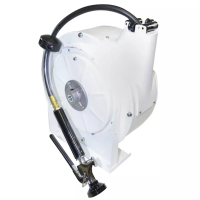Instruction Manual
D102005X012
846 Transducer
June 2017
24
To vary the pilot output pressure, the high‐velocity stream is diverted away from the receiver nozzle by the deflector,
which is a cylindrical, aerodynamic body located between the two nozzles.
In response to a change in actuator coil current, the deflector is repositioned between the nozzles. There is a linear
relationship between the coil current and the pilot stage output pressure. For direct action units, the power‐off, or
fail‐safe, position of the top of the deflector is near the center of the stream and results in nearly zero pilot output
pressure. As the coil is energized, the deflector is drawn out of the stream.
For reverse action units, the power‐off, or fail‐safe, position of the deflector is completely out of the stream. The result
is maximum pilot output pressure. As the coil is energized, the deflector moves into the stream, resulting in a
decreased pilot output pressure.
The deflector material is tungsten carbide, and the nozzles are 316 stainless steel. The nozzles have a large bore of
0.41 mm (0.016 inches), which provides good resistance to plugging.
Figure 12. Detail of Deflector/Nozzle Pilot Stage
W6287
Booster Stage
The receiver nozzle pressure controls the booster stage, which has a poppet valve design. An increase in receiver
nozzle pressure positions the valving in the booster stage to produce an increase in the transducer output signal. A
decrease in the receiver nozzle pressure positions the valving in the booster stage to allow exhaust to occur,
decreasing the output signal.
The booster stage operates using a 3:1 pressure gain from the pilot stage. High flow rate capability is achieved by large
flow area poppet design and internal porting having low flow resistance. The booster stage design provides very good
stability in high vibration applications, and the poppet valve technology provides resistance to plugging.

